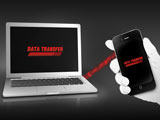At the speed of light on the data highway
It takes not only time but also patience to transmit large image files or Full-HD film sequences from one terminal device to another. A wired data transfer can thus sometimes take several minutes. “There has to be a faster way”, said the researchers at the Fraunhofer Institute for Photonic Microsystems IPMS, and developed a kind of highway for data links that uses light as a transmission medium. So, data can be transferred wirelessly with up to 5 gigabits per second (Gbit/s).

Getting from A to B as quickly as possible is just as important for data transfer as it is in traffic. And since the technical equipment in portable devices such as smartphones, tablets, digital cameras or camcorders is getting better and better, the amount of data being produced is constantly growing, often in the gigabyte range. Nevertheless, we still want to send our data from one device to another in next to no time, and with no interfering cable if possible.
Say goodbye to tangled cables
Dr. Frank Deicke from the Fraunhofer IPMS has set himself the goal of accelerating the wireless transfer of large amounts of data. As an alternative to the common USB 3.0 standard, he has thus developed a communication module that enables a data transfer rate of up to 5 gigabits per second (Gbit/s)! Contrary to the general trend, he does not use radio links such as Bluetooth or WLAN, but makes use of optical wireless data transmissions by means of infrared light. "The use of infrared light as a wireless transmission medium means that signal processing is up to 100-times faster than currently available solutions because the information does not have to be specially coded for radio transmission beforehand. What’s more, the bit error rates in the optical link are exceptionally low so that net data rates of up to 95 percent of what is theoretically possible can be achieved; the percentage for WLAN is much, much lower," explains Deicke, who goes on to point out another advantage of infrared technology: "The path via light needs only 15 percent of the energy per byte – something that particularly benefits mobile, battery-operated devices such as mobile phones or digital cameras". The only condition: there has to be a so-called "Line-of-Sight" connection, just like a remote control that works with IR. This assumes an unobstructed view between the transmitter and recipient. Deickes’ infrared communication module could soon replace the usual mess of cables with a high-speed wireless link that transmits large image and music files or HD film sequences "at the speed of light" from one terminal device to another.
From the consumer sector to industrial applications
The possible fields of use of the newly developed infrared communication modules are very diverse and range from the consumer sector through to industrial applications. It facilitates and accelerates not only the transmission of home holiday snaps and videos, but can also be used wherever large amounts of data have to be transmitted from one terminal device to another as quickly as possible - for example in safety and process control or medical technology. The Fraunhofer IPMS offers an evaluation kit that gives interested parties the chance to evaluate an optical, wireless data transmission with data rates of up to several gigabits in their target system.
About Fraunhofer IPMS
The Fraunhofer Institute for Photonic Microsystems IPMS is a leading international research and development service provider in the fields of photonic microsystems, microsystems technology and wireless microsystems. The Dresden research institute has many years of experience in the development of components, modules and systems for optical wireless communication and offers solutions for all speed classes in the multi-gigabit range for both infrared and visible light. The Fraunhofer IPMS is a member of the Infrared Data Association (IrDA) and is in charge of the 10 Giga-IR Special Interest Group.
 Fraunhofer Institute for Photonic Microsystems
Fraunhofer Institute for Photonic Microsystems